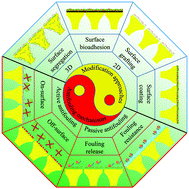Antifouling membranes for sustainable water purification: strategies and mechanisms
Abstract
One of the greatest challenges to the sustainability of modern society is an inadequate supply of clean water. Due to its energy-saving and cost-effective features, membrane technology has become an indispensable platform technology for water purification, including seawater and brackish water desalination as well as municipal or industrial wastewater treatment. However, membrane fouling, which arises from the nonspecific interaction between membrane surface and foulants, significantly impedes the efficient application of membrane technology. Preparing antifouling membranes is a fundamental strategy to deal with pervasive fouling problems from a variety of foulants. In recent years, major advancements have been made in membrane preparation techniques and in elucidating the antifouling mechanisms of membrane processes, including ultrafiltration, nanofiltration, reverse osmosis and forward osmosis. This review will first introduce the major foulants and the principal mechanisms of membrane fouling, and then highlight the development, current status and future prospects of antifouling membranes, including antifouling strategies, preparation techniques and practical applications. In particular, the strategies and mechanisms for antifouling membranes, including passive fouling resistance and fouling release, active off-surface and on-surface strategies, will be proposed and discussed extensively.


 Please wait while we load your content...
Please wait while we load your content...